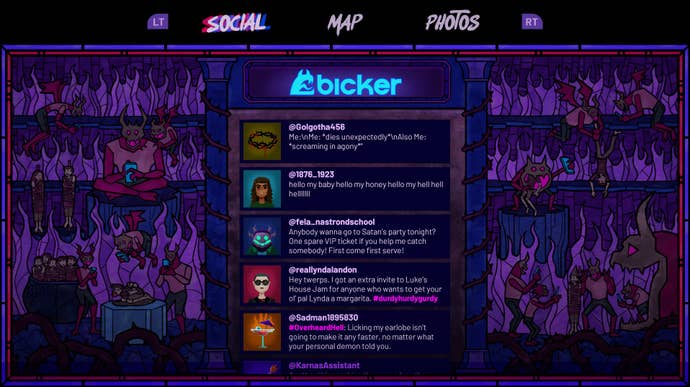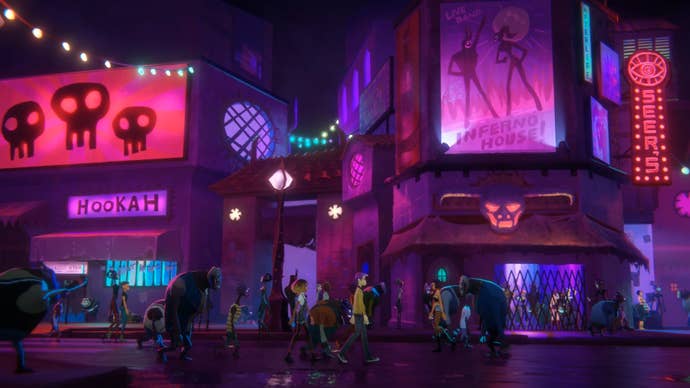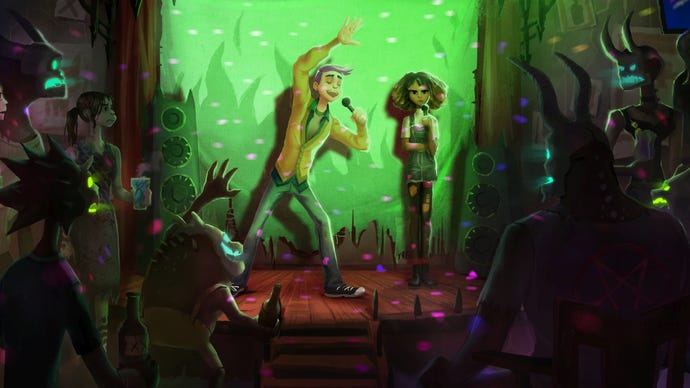The Making of Afterparty, the Indie From Hell
We talk with one of Night School's co-founders about life, drinking, and whether the devil has Wi-Fi.
This article first appeared on USgamer, a partner publication of VG247. Some content, such as this article, has been migrated to VG247 for posterity after USgamer's closure - but it has not been edited or further vetted by the VG247 team.
After a breakout debut like Oxenfree, Afterparty was supposed to be a sort-of palate cleanser for Night School Studio. Rather than a tense ghost story about teens struggling with past regrets and growing up, Afterparty's pitch is simple: party your way out of hell.
But funnily enough, Afterparty didn't start life as a game set in hell. "Initially, we were going to make it that you were a bartender, and that it was a single bar," says Sean Krankel, co-founder of Night School Studio. Then the first of a series of "a-ha" moments that would come to define Afterparty's world happened. "The more we talked, I was like, 'We want to do the drinking, not the pouring.'"
We spoke to Krankel just a short time before the release of Afterparty, which launched today. It's easy to draw lines from Afterparty to Oxenfree, from the same expressive art style to its youthful leads and interactive dialogue that bubbles up as you walk from place to place. But this isn't the haunted island of Oxenfree; Afterparty takes place in the afterlife, as dual-protagonists Milo and Lola seek a second shot at life by out-drinking the devil himself.
Night School Studio rallied around this idea of a pub crawl, but soon it became clear there was no antagonist. Without some sort of driving force, what separates Afterparty from just another wild night out on the town?
"We were just like, well, who's the hardest-core motherf**ker you'd want to go up against drinking? And then we just started talking about Satan as we were walking through this cemetery across the street from our office," Krankel says. "It just kind of perfectly coalesced."
As it turns out, that devilish revelation led to even more ideas. Night School Studio went to work designing its own version of hell, not strictly adhering to any religious or fictional portrayal of the here-after, but their own. "It doesn't have to be the heavy metal, Iron Maiden, Black Sabbath hell," Krankel says.
The team designed their own version of hell as an analogue of real-world nightlife, filled with both fantastic wonder and the devilish instruments of torture you would expect. Krankel drew comparisons to Shibuya and Amsterdam, coated with a veneer of pain and suffering. "It's like an R-rated Pixar hell," Krankel says.
It is, he says, as if every religion was "sort of right," with islands dotting the River Styx, laying out your path to Satan and salvation. A studio mandate was to buck traditions. Avoid reds and oranges, and instead, dive further into what Night School's hell could be.
Of course, the center is still Milo and Lola. The two provide an interesting dynamic compared to the largely solo protagonist of Oxenfree, Alex. Krankel describes Milo and Lola as a symbiotic organism, and since the player starts the game with control of both, they each become different evolving facets of your playthrough.
"The game really is about this nature of a long-term friendship, and what it is to be friends with somebody since you were five years old," Krankel says. "And the upside of that, the downside of that. How that can get pushed and pulled."
Milo is the awkward guy, who throughout college wanted to be more sociable and live the Animal House kind of life. He hopes graduation will be like a reset, to start over and wash away past social failures. But Lola is the opposite side of the coin: her complete apathy toward being cool makes her cool, and her post-grad dreams lie elsewhere. They're two sides of the same person, dynamics that Krankel says everyone has versions of inside themselves.

How these two evolve and grow over the course of Afterparty is best left to the game to illustrate, but Krankel tells me these goals can change drastically based on your playstyle. A large part of Afterparty is the way your playstyle can start to color and affect the narrative around you; while Oxenfree has pivotal choices, here in Afterparty, even minor decisions like what drink to order might change the way demons of hell react to you.
This is all portrayed best through Bicker, hell's social media platform (because of course Twitter exists in hell). Bicker posts will pop up around you, commenting on the night's events. They might cheerfully post "fresh meat" when you walk into an especially gritty dive, or mock your dance moves. They may even support you, laughing at a demon who's losing an arm wrestling contest to a human. It's amazing that of all the instruments of torture, social media can do the job just as well thanks to hell's apparently Wi-Fi capable infrastructure.
"They probably have Wi-Fi," Krankel says when I ask how the cells can handle Bicker posts in the underworld. "I don't know if the service is great, but yeah."
The greatest challenge with Afterparty was the sheer scope of the project. Though Krankel says the script for Afterparty is "probably only a little bit bigger" than the Oxenfree script, the locales and inhabitants were huge compared to Oxenfree's isolated island and small group of teen leads.
"With Oxenfree, at most you had five characters on screen," Krankel says. "Most of the time it's two or three. In this game, because we're walking around in a bunch of different bars, there's 20, 30-plus characters on-screen doing their own dancing, ordering their own drinks, getting drunk. You know, all this stuff that just from an art and implementation perspective created a lot of challenges for the team."
Night School expanded from a handful of developers to a team of 12 people and several contract designers, all brought on to make the studio's vision of hell work just right. Add in a complex narrative, and Night School had its hands full.
Though, a story about over-indulgent drinking can veer into tough topics. Pub crawls can be light-hearted, but I was curious as to how the team tackled the harder concepts around excessive drinking, and whether Afterparty ever addresses that side of itself.
"The story absolutely does, the further you go in," Krankel says. "It's not just, you know, chug-chug-chug, vomit, feel bad, have your life go down the tubes."

Part of levying that narrative weight was reimagining what drinking would be like in an immortal afterlife. While you might start out with pretty standard fare, the liquors quickly veer into tonics and concoctions more akin to Harry Potter than The Hangover. They'll make you talk like a pirate or Vaudevillian actor, or vomit up your conscience like Jiminy Cricket. But Krankel says they also explore how everyone in their hell has a different relationship with drinking: the social aspects, the dependency, and the act itself.
"It's not just about Milo and Lola imbibing," Krankel says. "It's about everybody in this world, [and] their relationship with it, Satan included."
It might seem strange to look at what's next with Afterparty, considering the team just launched a game, but as Krankel tells me, Night School Studio is a small team. It has to keep moving. It's not just about production, though; it sounds like the developers are already thinking about what's next, and considering what early concepts might be for the next Night School project. Krankel says the team already has a couple of ideas, with one they already feel pretty good about and will start working on closer to the holiday season.
When we talk about where narrative games like Night School's can go, I draw comparisons to recent hits in the space like Florence and What Remains of Edith Finch. Krankel tells me Night School likes to think of how communication and narrative can be a toy, how it can be used to better tell stories. He says both those games are stories made better by the way you interact with mechanics, rather than just being a cool story with some other gameplay attached.
But it sounds like the most important part is having a succinct pitch. Krankel identifies the Untitled Goose Game as a kindred project, in that it also had a very straightforward appeal that caught your eye, whether you're familiar with games or not.
"We always want to come up with an idea that's not so esoteric to games that you can't just explain it to anybody," Krankel says. "So 'party your way out of hell' was pretty easy for anybody to wrap your head around."
Afterparty is live today for PlayStation 4, Xbox One, and PC via the Epic Games Store. You can read our review of the game here.


